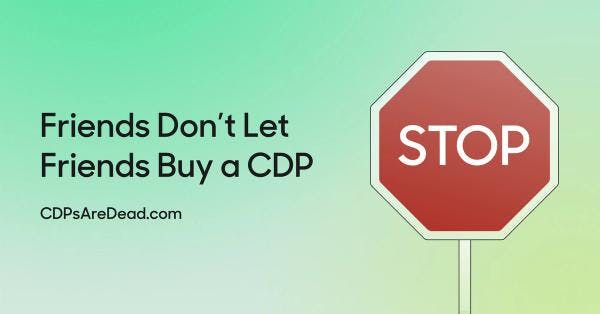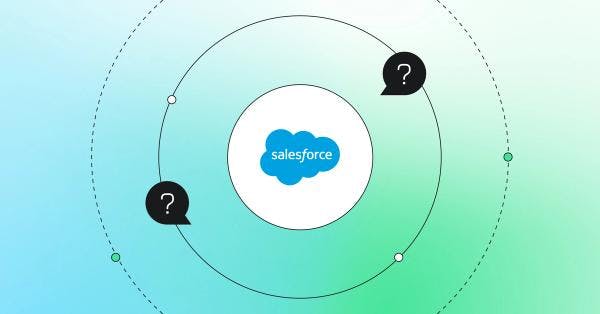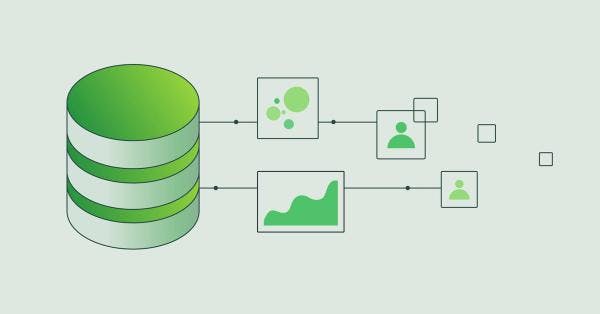Dark Clouds: the broken promises of Salesforce CDP
Sales, Service, and Marketing Cloud are industry staples. Salesforce’s CDP is the wrong way to get data into them.

Tejas Manohar
February 28, 2024
11 minutes
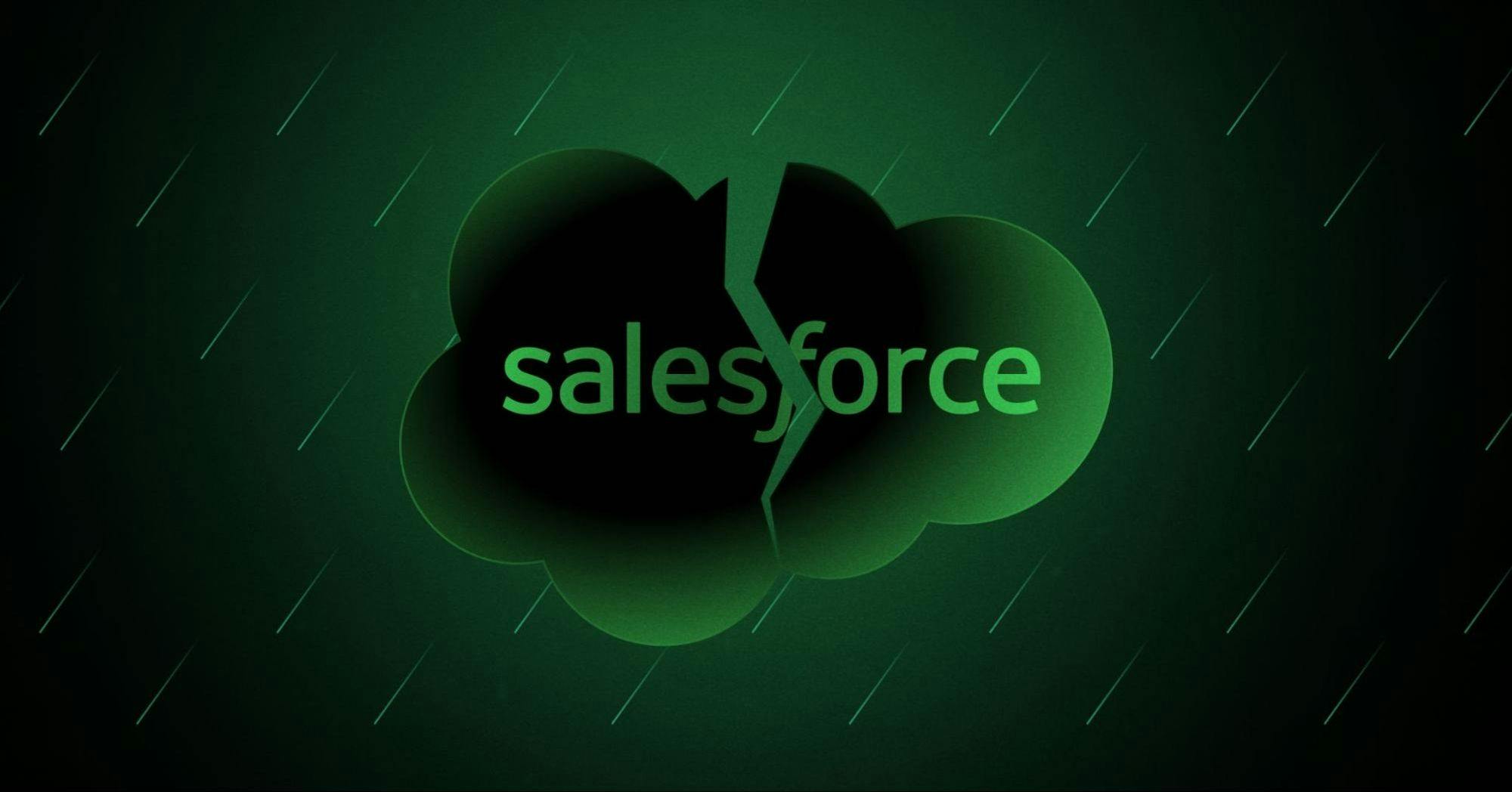
We’ve attracted plenty of attention over the last few years by stating that "Friends Don’t Let Friends buy a CDP". But despite our efforts, traditional Customer Data Platform (CDP) implementations continue to lead companies to burn vast amounts of money and time, only to wake up 12+ months later with nothing to show for it. Today, I want to talk to you about the worst offender I see in the market: Salesforce.
Usually, buying Salesforce is a safe bet. Sales Cloud has long been the definitive customer relationship management (CRM) platform against which all competitors are judged. Marketing Cloud (SFMC) is similarly well-established for customer outreach, as is Service Cloud for customer service. Buying Salesforce’s CDP, on the other hand, is one of the worst decisions a marketing or data leader can make.
Salesforce has notoriously been trying–and failing–to win the CDP market for years. They have literally launched five different CDP rebrands in five years– Customer 360, Salesforce CDP, Marketing Cloud Customer Data Platform, Salesforce Genie, and now, Salesforce Data Cloud for Marketing. We’ve talked to dozens of customers aggressively upsold into Data Cloud for Marketing by a Salesforce Account Manager (often with “first-year-free” incentives) and were sorely disappointed by the platform.
In this blog, we’ll examine Data Cloud’s shortcomings based on experiences from real customers using it, dig deeper into how it works, and offer some guidance for the best ways to actually marry a CDP with Salesforce Sales and Marketing Clouds.
Shortcomings of Salesforce’s CDP
Big promises, little follow-through. Salesforce’s team is great at presenting at conferences and presenting a vision in sales calls with robust slideware. There’s typically a huge gap between their promises and the reality of their product. (Case-in-point: a former product leader is suing Salesforce for wrongful termination after he pushed back against outright lies about their CDP’s capabilities). We’ve found from talking with our customers and our own experience that if you see a Salesforce slide deck that promises you a key CDP feature is “six months out,” the safe assumption is that you shouldn’t expect it to exist anytime soon.

Separate data silo. Salesforce Data Cloud can only act on data that is stored directly in Salesforce. Some team members will rely on the partial data store within Salesforce, while others will refer to your more complete data stored in a data warehouse or other databases. This leads to confusion and means that the campaigns powered by Salesforce as your CDP will be informed by partial or even incorrect data.
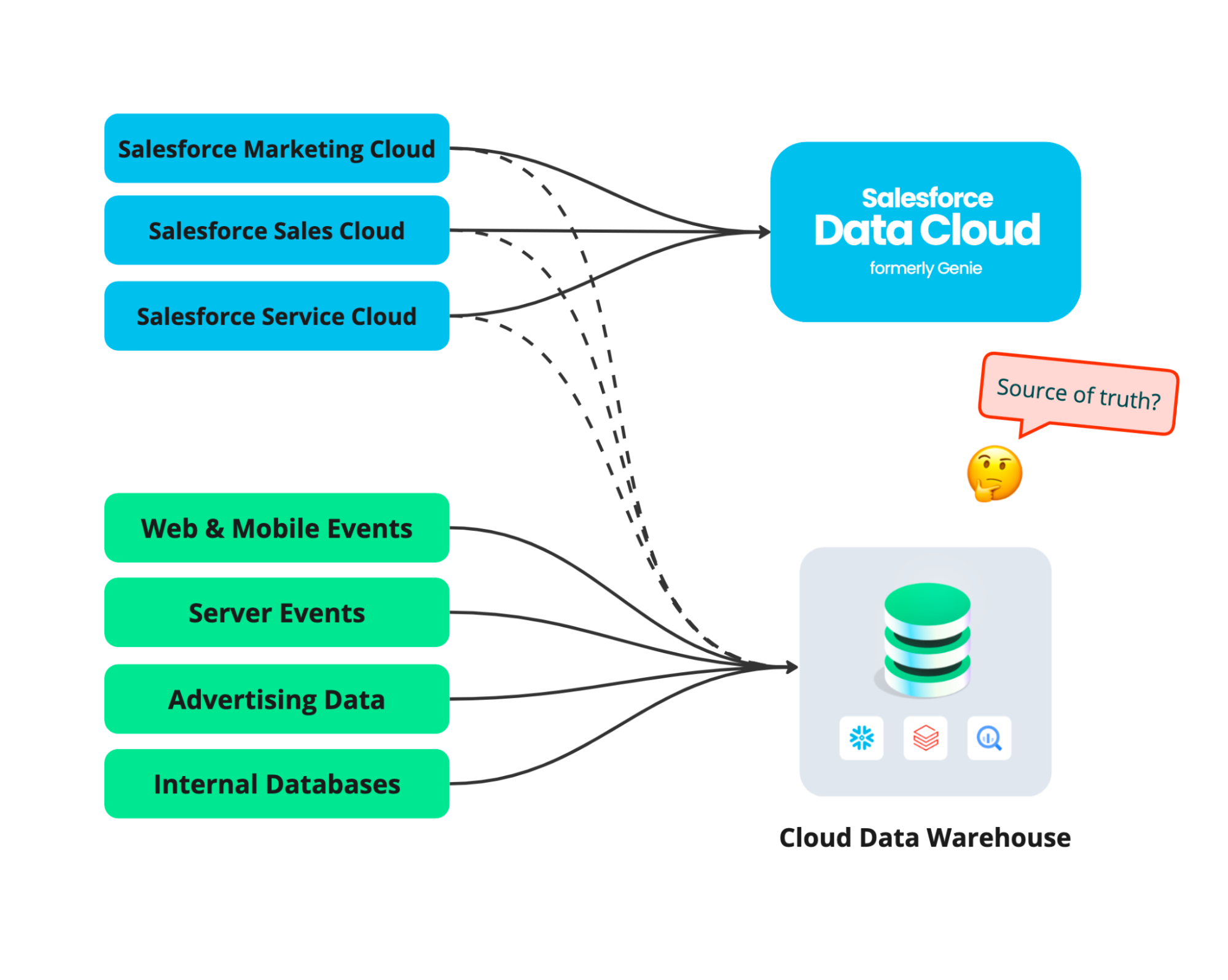
Poor data warehouse connectivity. Salesforce has said seamless integrations with data warehouses (“zero-ETL” or “zero-copy”) were coming “in the near future” since September 2022. Unsurprisingly, it’s still not available. In reality, getting data into Salesforce Data Cloud from most data warehouses and databases requires you to build new pipelines that copy and ingest data into Salesforce Data Cloud. Sometimes, they even force you to buy a band-aid solution like Mulesoft… that is also sold by Salesforce. Get used to hearing some version of: “Is your implementation going badly? Here, buy more Salesforce.”
The delays and costs are bad enough, but in practice, this lack of connectivity exacerbates Data Cloud’s status as an incomplete source of truth. It also means that the amazing work your data team is doing in your own infrastructure, such as building machine learning models and aggregating offline customer conversion data, doesn’t make it into Salesforce Data Cloud.
Limited integrations with external tools. Just like Salesforce Data Cloud for Marketing only “plays nice” when ingesting data from Salesforce sources, it similarly fails to activate data outside the Salesforce ecosystem. Salesforce can only sync data out to a few advertising and marketing destinations, far short of the hundreds that other traditional and Composable CDPs support. Take a look at the platforms your team is using today to reach customers. If any of them live outside of Salesforce’s ecosystem, chances are they don’t natively integrate with Salesforce’s CDP, and you’ll have to build your own pipelines or upload CSV files manually.
Long delays getting data to marketers. Even if you just want to use your customer data inside of Salesforce’s tools, it still takes a long time for it to be accessible for marketers. When new data streams into Data Cloud, it only updates Salesforce Marketing Cloud every hour or, depending on the data type, just once a day. This may be sufficient for some marketing but is not timely enough for time-sensitive campaigns or triggers based on customer actions.
Rigid data requirements. Salesforce Data Cloud for Marketing does not accommodate the diverse data of modern enterprises. Data Cloud really only works if all you care about is individual customers; more complex entities like households, playlists, or pets quickly make implementation a mess. For example, every object within Data Cloud must be mapped to an individual, and the audience builder only works on users and accounts. Identity resolution is similarly rigid, only matching on identifiers that exist within your Salesforce ecosystem (e.g., Service Cloud ID, Marketing Cloud Subscriber Key, Web Cookie, etc.). Even more generally, you can only transform data in Salesforce’s bespoke UI and, therefore, can’t take advantage of popular tools like dbt or the work on AI that your data team is doing elsewhere.
Difficult and time-intensive implementation. Due in large part to Salesforce’s Data Cloud’s rigid data requirements, implementing it typically takes months of expensive effort. And if you can’t staff it, that means thousands of consulting hours. This isn’t cheap and comes with a big opportunity cost too, as other solutions can earn revenue far more quickly.
Expensive. Salesforce is luring many customers to its Data Cloud product with first-year free or heavily discounted offers– but the platform itself is seriously expensive. Baseline prices are hundreds of thousands of dollars a year before considering add-ons, extraordinarily complicated usage-based pricing, and any service hours you’ll require. Given the lock-in that you’ll feel after spending months implementing Data Cloud, these costs are likely to burden your organization for years to come as you untangle a failed investment.
How Salesforce’s Data Cloud for Marketing Works
In many ways, Salesforce Data Cloud for Marketing works like a traditional CDP. It first collects customer data into a storage silo, then unifies it into customer profiles before finally allowing marketers to take action with that data. We’ve written more extensively about how Salesforce Data Cloud for Marketing works in this blog, but read on for an abbreviated summary.
Data collection relies on streams and works best when collecting and ingesting data from other Salesforce products within your organization. Despite multiple claims that Salesforce “will soon” develop zero-copy native warehouse integrations, it’s clunky to copy data from your data warehouse into Salesforce. This can be a critical bottleneck because you’ll want to use non-Salesforce information like offline data, first-party attributes, and data science models to power your marketing activities.
Data modeling and identity resolution also take place within Salesforce Data Cloud. Salesforce Data Cloud forces users to use a bespoke UI, which requires specialized knowledge (or, often, billable service hours) and also requires significant effort to rearchitect when you add new data sources or attributes. This only grows more difficult to manage as you layer in other custom entities besides people your business may care about (such as households, accounts, or companies) and as you work to conform your data to Salesforce’s rigid standards.
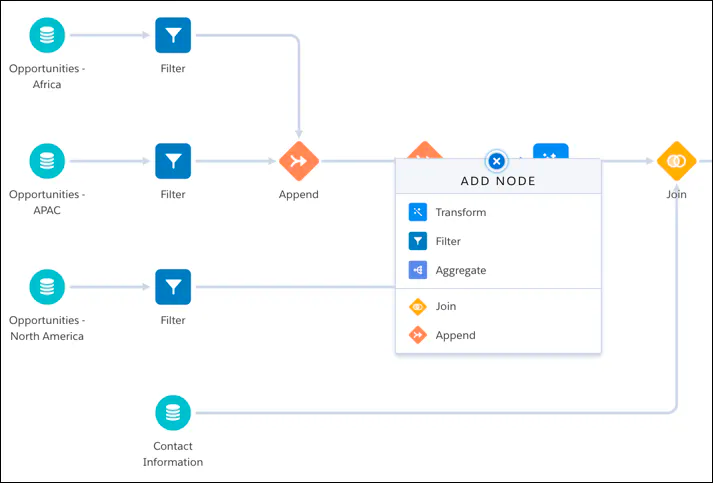
Data modeling in Salesforce
Finally, marketers take action with their customer data by assembling audiences in a visual builder and then triggering campaigns with those audiences. Just like data ingestion favors the Salesforce ecosystem, so too does data activation: Salesforce is only really good at triggering campaigns within Salesforce Marketing Cloud. SFMC is a powerful and beloved tool– but hardly sufficient for everything that marketers need to do. Unlike traditional and composable CDPs, which can sync data to hundreds of external advertising and lifecycle marketing tools, Salesforce CDP only supports a handful of external destinations for their audiences.
Finding a Better CDP for Your Salesforce Investments
I’ll reiterate: we’re huge fans of Salesforce’s Sales and Marketing Clouds. They are top-notch products for sales and marketing teams. However, if you want to power these clouds with customer data and a CDP, Data Cloud for Marketing isn’t the best way. It’s an expensive, unproven product that will hinder your progress and cost you a ton of time and money.
Leading enterprises, including PetSmart, Ramp, Intelycare, Heap, Blend, CircleCI, and Zeplin use Hightouch and their data warehouse to create a Composable CDP to power Salesforce Marketing Cloud. This has several key benefits:
Complete and flexible data. You can power your marketing with all of the data your company collects. You aren’t limited by the data Salesforce Data Cloud can ingest: if you’re collecting data anywhere, Hightouch can leverage it for your marketing. Similarly, if your data team is running any Machine Learning models or other custom transformations, all of your marketing will benefit from those.
Use your data anywhere– quickly. Hightouch natively syncs data to more than 200 marketing, advertising, and operational tools. Wherever you want to use your customer data, you can. While Salesforce Data Cloud can only serve Salesforce-powered use cases for your data, the Composable CDP can serve your entire organization. Plus, Hightouch can sync data at low latencies (including in real-time with Streaming Reverse ETL), so you can support time-sensitive marketing campaigns.
Fast time-to-value, low cost. You can set up syncs from your data warehouse to Salesforce destinations in just minutes. Total setup time for a Composable CDP is typically just a few weeks because it relies on your data team’s work in the warehouse rather than a bespoke data model in a separate system. The total cost of a Composable CDP is also far less (and far less complicated to manage) than Data Cloud.
Better support for Salesforce Marketing Cloud. SFMC is one of the most popular destinations for data syncs from Hightouch. This integration is faster, easier to use, and more configurable than the one from Data Cloud to SFMC. In fact, our customers prefer us so much that they keep asking us to move features upstream from Salesforce into Hightouch– such as automatically creating Data Extensions and Data Folders, and managing granular permissions around which Business Unit and Data Folder a marketer can upload to. In other words, for many of our users, we’ve become the preferred interface for how they interact with Salesforce Marketing Cloud because of how robust our integration is and how much easier we are to use than Salesforce.
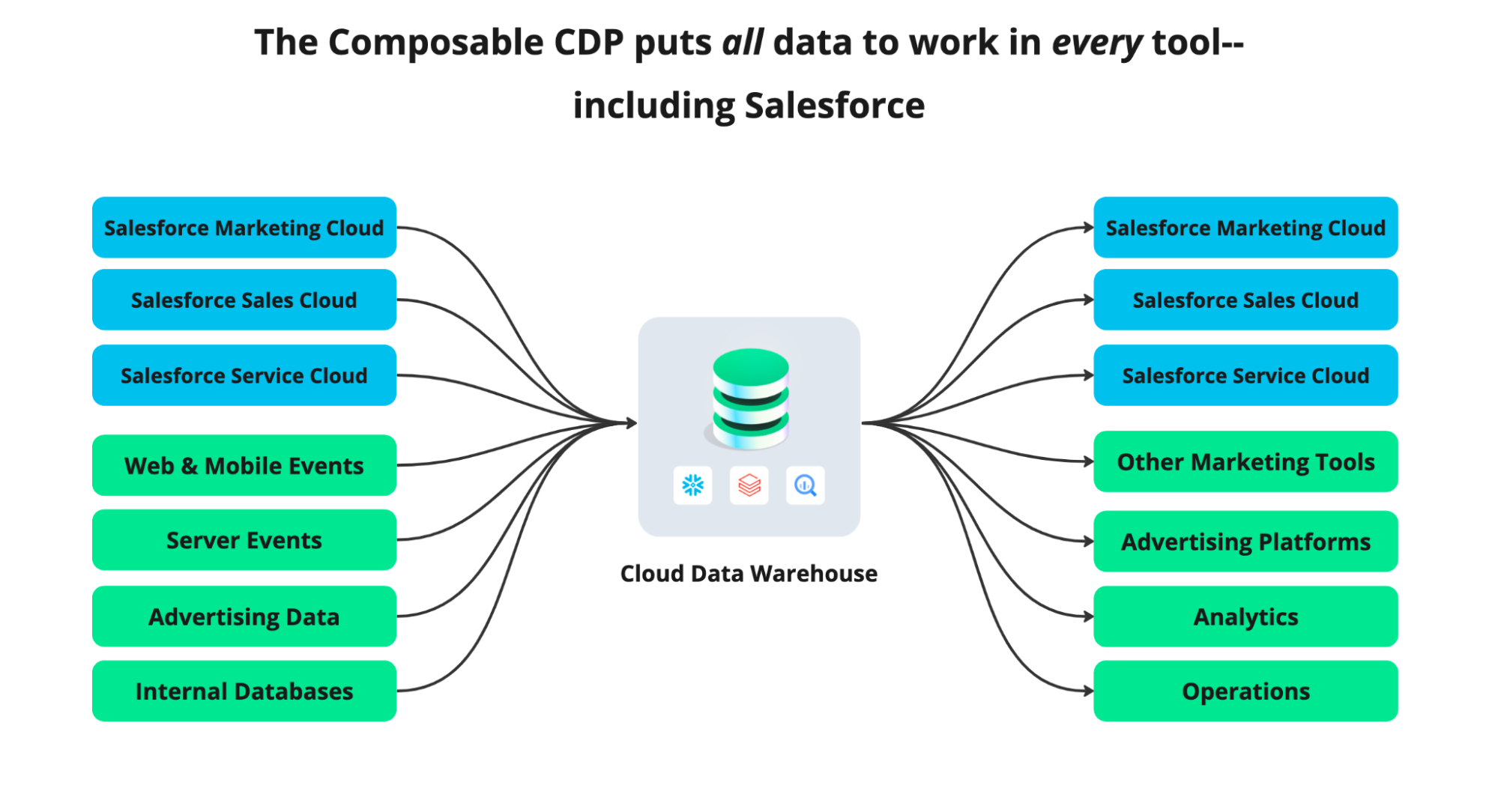
If you’re having trouble with Salesforce Data Cloud for Marketing, or want to learn about better ways to use a CDP with Salesforce, reach out to me at tejas@hightouch.com or book a demo with our solutions engineers.
